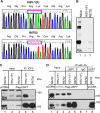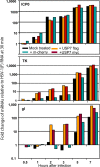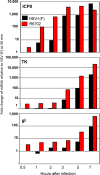Overexpression of the ubiquitin-specific protease 7 resulting from transfection or mutations in the ICP0 binding site accelerates rather than depresses herpes simplex virus 1 gene expression
- PMID: 22993145
- PMCID: PMC3497670
- DOI: 10.1128/JVI.01981-12
Overexpression of the ubiquitin-specific protease 7 resulting from transfection or mutations in the ICP0 binding site accelerates rather than depresses herpes simplex virus 1 gene expression
Abstract
Earlier studies reported that ICP0, a key regulatory protein encoded by herpes simplex virus 1 (HSV-1), binds ubiquitin-specific protease 7 (USP7). The fundamental conclusion of these studies is that depletion of USP7 destabilized ICP0, that ICP0 mediated the degradation of USP7, and that amino acid substitutions in ICP0 that abolished binding to USP7 significantly impaired the ability of HSV-1 to replicate. We show here that, indeed, depletion of USP7 leads to reduction of ICP0 and that USP7 is degraded in an ICP0-dependent manner. However, overexpression of USP7 or substitution in ICP0 of a single amino acid to abolish binding to USP7 accelerated the accumulation of viral mRNAs and proteins at early times after infection and had no deleterious effect on virus yields. A clue as to why USP7 is degraded emerged from the observation that, notwithstanding the accelerated expression of viral genes, the plaques formed by the mutant virus were very small, implying a defect in virus transmission from cell to cell.
Figures










Similar articles
-
Identification of a novel higher molecular weight isoform of USP7/HAUSP that interacts with the Herpes simplex virus type-1 immediate early protein ICP0.Virus Res. 2008 Oct;137(1):64-71. doi: 10.1016/j.virusres.2008.05.017. Epub 2008 Jul 17. Virus Res. 2008. PMID: 18590780
-
Structural Characterization of Interaction between Human Ubiquitin-specific Protease 7 and Immediate-Early Protein ICP0 of Herpes Simplex Virus-1.J Biol Chem. 2015 Sep 18;290(38):22907-18. doi: 10.1074/jbc.M115.664805. Epub 2015 Jul 29. J Biol Chem. 2015. PMID: 26224631 Free PMC article.
-
Impact of the interaction between herpes simplex virus type 1 regulatory protein ICP0 and ubiquitin-specific protease USP7 on activation of adeno-associated virus type 2 rep gene expression.J Virol. 2006 Apr;80(7):3650-4. doi: 10.1128/JVI.80.7.3650-3654.2006. J Virol. 2006. PMID: 16537633 Free PMC article.
-
Role of ICP0 in the strategy of conquest of the host cell by herpes simplex virus 1.J Virol. 2004 Mar;78(5):2169-78. doi: 10.1128/jvi.78.5.2169-2178.2004. J Virol. 2004. PMID: 14963113 Free PMC article. Review. No abstract available.
-
Ubiquitin-Specific Peptidase 7: A Novel Deubiquitinase That Regulates Protein Homeostasis and Cancers.Front Oncol. 2021 Nov 19;11:784672. doi: 10.3389/fonc.2021.784672. eCollection 2021. Front Oncol. 2021. PMID: 34869041 Free PMC article. Review.
Cited by
-
HAUSP regulates c-MYC expression via de-ubiquitination of TRRAP.Cell Oncol (Dordr). 2015 Aug;38(4):265-77. doi: 10.1007/s13402-015-0228-6. Epub 2015 Apr 30. Cell Oncol (Dordr). 2015. PMID: 25925205
-
The Ubiquitin-Specific Protease Usp7, a Novel Merkel Cell Polyomavirus Large T-Antigen Interaction Partner, Modulates Viral DNA Replication.J Virol. 2020 Feb 14;94(5):e01638-19. doi: 10.1128/JVI.01638-19. Print 2020 Feb 14. J Virol. 2020. PMID: 31801860 Free PMC article.
-
Cellular Transcriptional Coactivator RanBP10 and Herpes Simplex Virus 1 ICP0 Interact and Synergistically Promote Viral Gene Expression and Replication.J Virol. 2016 Jan 6;90(6):3173-86. doi: 10.1128/JVI.03043-15. J Virol. 2016. PMID: 26739050 Free PMC article.
-
Crystal Structure of USP7 Ubiquitin-like Domains with an ICP0 Peptide Reveals a Novel Mechanism Used by Viral and Cellular Proteins to Target USP7.PLoS Pathog. 2015 Jun 5;11(6):e1004950. doi: 10.1371/journal.ppat.1004950. eCollection 2015 Jun. PLoS Pathog. 2015. PMID: 26046769 Free PMC article.
-
Novel roles of cytoplasmic ICP0: proteasome-independent functions of the RING finger are required to block interferon-stimulated gene production but not to promote viral replication.J Virol. 2014 Jul;88(14):8091-101. doi: 10.1128/JVI.00944-14. Epub 2014 May 7. J Virol. 2014. PMID: 24807717 Free PMC article.
References
-
- Boutell C, Everett RD. 2003. The herpes simplex virus type 1 (HSV-1) regulatory protein ICP0 interacts with and ubiquitinates p53. J. Biol. Chem. 278:36596–36602 - PubMed
-
- Canning M, Boutell C, Parkinson J, Everett RD. 2004. A RING finger ubiquitin ligase is protected from autocatalyzed ubiquitination and degradation by binding to ubiquitin-specific protease USP7. J. Biol. Chem. 279:38160–38168 - PubMed
Publication types
MeSH terms
Substances
Grants and funding
LinkOut - more resources
Full Text Sources
Research Materials

